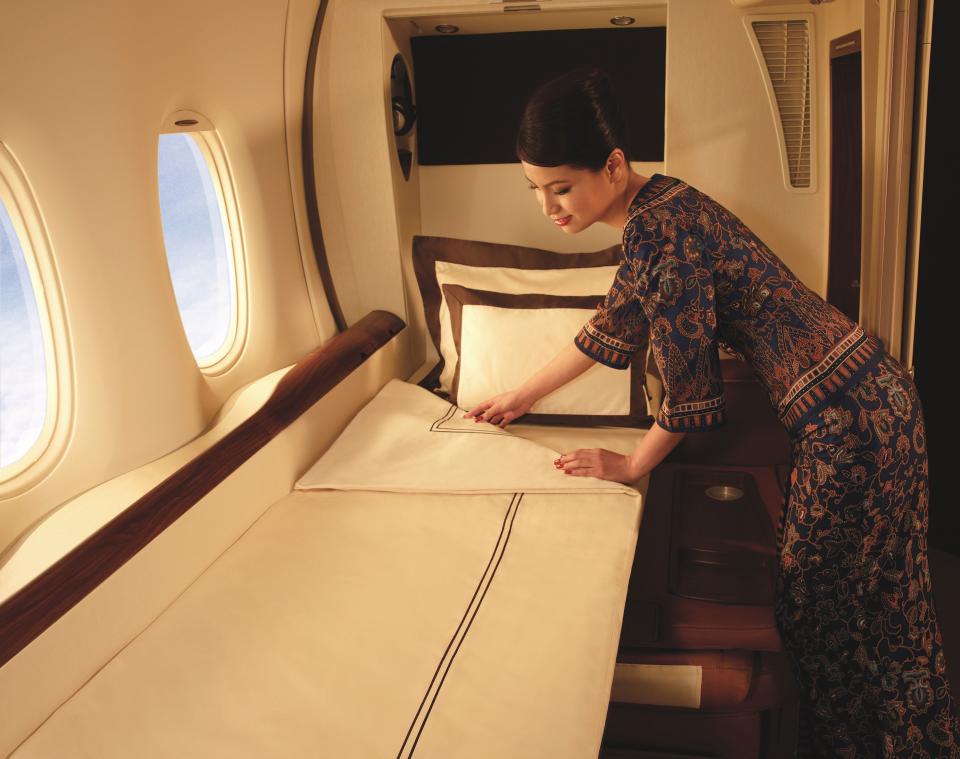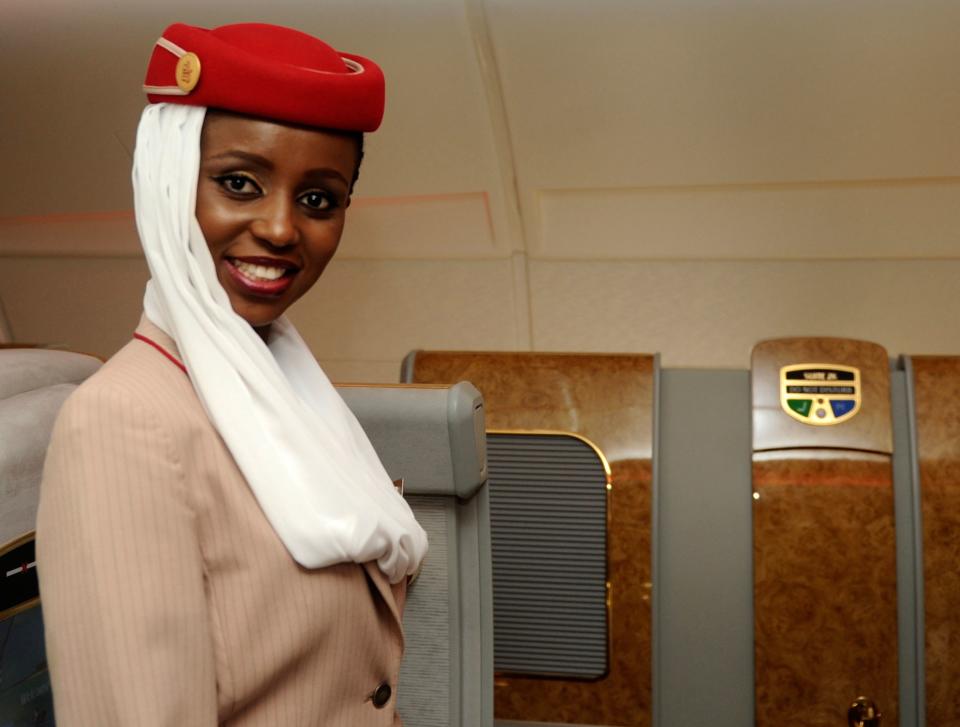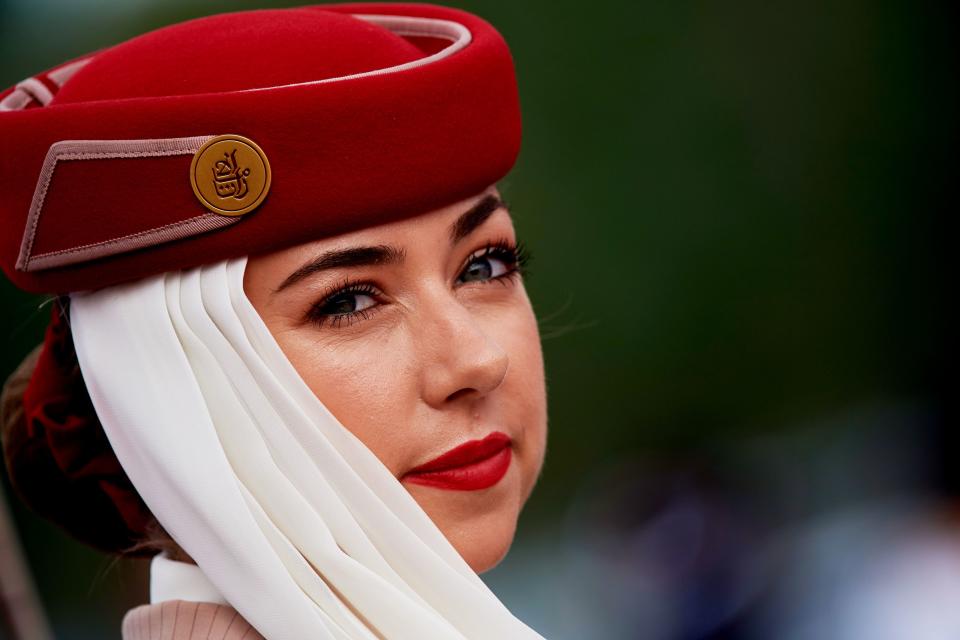What It's Like to Be a Flight Attendant For the World's Fanciest First-Class Airlines
Seven miles over the Java Sea, en route from Singapore to Sydney, there is an emergency.
My glass of vintage 2006 Dom Perignon is getting perilously low. Before I can register my internal panic, the door to my cabin slides open and an angel (earthly name: Kelly) appears. In one seamless gesture, Kelly refills my champagne flute, places a fresh, starched linen napkin on my lap (I spilled some caviar), and scans the room for anything out of place — all while smiling at me as if I had just said something very droll (I hadn’t).
Meet the Singapore Girl. She is a paragon of Asian hospitality, and the most enduring brand ambassador of an international airline with a sterling reputation for quality service. (It was rated best in the world by TripAdvisor in 2018.) “We train the crew to anticipate the customer’s needs,” says Foo Juat Fang, a soft-spoken but formidable manager at Singapore Airlines’ vast training facility. I felt my needs had been very anticipated, spookily so, traveling in suites class, which is basically a luxury hotel room in the sky and a step above first. The bedding (there is a 76-by-27-inch separate lie-flat bed) and the crystal are by Lalique, as are the PJs, slippers, and amenity kits; the leather upholstery is by Poltrona Frau; the china is Wedgewood; and the overall design is by Jacques Pierrejean. Kelly, my champagne savior, is wearing a Balmain uniform.
From the dawn of the jet age, the mystique of the stewardess — sorry, flight attendant — sorry, cabin crew member — has been a part of our cultural mythology. Even as a kid, I was hooked. Coming from a smallish town in Connecticut, I thought the job was beyond glamorous. Perhaps the glamour was in inverse proportion to my sophistication (or lack thereof). I once addressed an aerogram to a childhood pen pal as “Paris, France, Europe,” which my mother (rest her soul) found endlessly amusing. There was also the “Coffee, tea, or me?” trope in various comedy skits that adults seemed to chuckle at — I didn’t know why, but I laughed along. The line even became a TV-movie title in 1973, for a film about a stewardess, natch, played by Karen Valentine, a future neighbor. Years later, when she came to a holiday party at my house, she baked a tray of Christmas cookies and I said, “Coffee, tea, or treats?” She smiled as if I had just said something very droll.
The mod, sexy romance of the stewardess/flight attendant/cabin crew member got a huge boost in the mid-1960s, when groundbreaking adwoman Mary Wells Lawrence launched a campaign for Braniff International Airways titled “The End of the Plain Plane.” The jets were adorned with vibrant colors, inside and out. She hired Emilio Pucci to design the crew uniforms, which had sock-it-to-me prints in colors that could be seen from space. The first uniform was actually called the Gemini IV and came with a space bubble helmet. One ad, meant to lure businessmen, was a little naughty and sexually suggestive. It was called “Air Strip,” and it was exactly what it sounds like.
Lawrence’s genius was to market air travel as a chic, though attainable, adventure. It was a party in the sky. She sold both the destination and the journey. And she seemed to know that the keys to her pitch were style and service, specifically the service from the air hostesses (sorry, highly trained cabin crew professionals). Fifty-some years later, two of the world’s top airlines, Emirates and Singapore, are still working from a similar playbook, especially in first and business class. (Both airlines provided travel accommodations to Allure for this story.) Between them, they are piling on the perks: onboard showers, ever more sophisticated wine and food programs, in-flight lounges with snacks and bubbly and single malts, luxury-branded amenity kits, big-screen, high-def entertainment systems, and roomy, fully reclining seats that give new meaning to the phrase “Netflix and chill.” And yet, says Catherine Baird, senior vice president for cabin crew training at the Emirates Aviation College in Dubai, “it all comes down to service and the way the crew engage with the customers — the human connection that defines the experience.” Put another way: high-altitude attitude.
You’re lucky if you receive a grunt and a bag of stale nuts from the crew on many domestic routes, but when I board an Emirates flight to Dubai, it’s as if I’m entering the world of the super nice, super happy, and super accommodating. No fewer than three cabin crew members (two women and one man) greet me with what can only be described as Broadway-chorus-line smiles. I would not have been at all surprised if, before opening the door to passengers, a supervisor had shouted, “It’s showtime!” Being medically allergic to excess enthusiasm, I find myself searching for the do not disturb button, which, once located, I don’t use. I just need to know it’s there. David Bowie’s “Starman” is playing on the overhead speakers, and it seems an appropriate soundtrack for flying into the sparkling night sky toward the mysteries of Arabia. After we finish our climb, the captain proudly announces, in Arabic and American-accented English, that the crew are comprised of 12 nationalities and speak 13 languages. This diversity is a point of pride for Emirates and dovetails well with the strategy of making its home airport, Dubai International, the crossroads of the world.
Where the Singapore crew is reserved, elegant, and refined, the Emirates crew is outgoing, fun, and sporty. (The airline sponsors many big sporting events, and one promotion features a crew member, in uniform, complete with hat and veil, throwing out the first pitch at a Los Angeles Dodgers game; she fires it over the plate to roars and applause.) Gold is an important status symbol in Dubai and other parts of the Middle East, and to say Emirates first class is a gleaming realm would be a bit like saying the desert is sandy. Yes, it’s over the top. But sometimes good taste is overrated. (Jewelry on the crew, however, must be minimal and discreet.) In such a gilded environment, you’d think that romances between the young, beautiful, generally single women of the crew and the pampered travelers in first and business class would be coffee-tea-or-me common. You would be wrong. “In my experience, there are no Cinderella stories,” says a former crew member who flew with Emirates for three years, from age 27 to 30, a comment echoed by others. “No one I knew of met their Prince Charming in first class and lived happily ever after,” she says. “It’s always the same story: guys cheating on their wives or girlfriends.”

At both airlines, appearance standards are rigid. In 1968, couturier Pierre Balmain designed the instantly recognizable sarong kebaya for Singapore (then Malaysia-Singapore Airways). Color coded by rank (blue, green, red, purple), the style, as seen above, has changed little since then and features in all the airline’s ads. Balmain made the kebaya very snug around the hips and bust, creating a classically feminine silhouette, and left instructions that they be customized for each woman for the most flattering fit. “If a girl gains a little bit of weight,” says Foo, in a compassionate way that nevertheless sends shivers down my spine, “we might have to have a conversation.”
Posture is also key. You don’t want to slouch in Balmain. Posture, in turn, informs the walk. Singapore Girls don’t so much stride as glide. A group of them gracefully moving through the great marble expanses of the island’s Changi Airport on the way to a departure is a sight to behold. People stop and stare. Hair needs to be up in a French twist, or pulled back in a tight bun, or styled in a bob or pixie cut. It’s black or dark brown, thick and lustrous in every case I observed. And then there’s the smile. “It must be genuine,” says Foo. “It doesn’t matter if you’re having a bad day — you must leave your troubles at home.” In the Lancôme beauty lab at the training center, recruits are given makeup palettes to flatter their skin tone and, as they advance, to complement different-color uniforms. There’s a general sense of restraint: You’re not going to see an exaggerated smoky eye or contouring. And I’m told false eyelashes are not advisable; they could fall into a customer’s velouté.

Del395326
United Emirates flight attendantsEmirates uniforms have their own flair, if not the same high-fashion pedigree. The most recognizable feature is the bright red hat and white veil. There are also contrasting flashes of red on the beige skirt’s kick pleats (crew members may choose to wear pants for religious reasons or personal preference). In the makeup room at Emirates Aviation College in Dubai, I get a demonstration, in which a crew member is transformed from beautiful to Emirates cabin crew beautiful.
“This is all about the lips, complementing the strong red of the hat and uniform,” says image consultant Pamela. Nevertheless, she starts with the eyes (after applying sunscreen and a very light touch of foundation that matches her model’s olive skin tone). Then she begins to work with eyeliner, shadow, and mascara. “All colors are fine, as long as they are brown or black,” she says. In my ignorance, I laugh, thinking that was almost an oxymoron, but on reflection, she clearly meant the many variations of brown or black. Duh. Lips are lined and filled, lined and filled, lined and filled in an emphatic red. Then Pamela applies a bit of blush, a little highlighter (“No contouring necessary”), a moisturizing setting spray, and presto — that Emirates glow! Longer hair needs to be up and gathered in a French twist or a bun, much like with the Singapore crew, and jewelry is restricted to classic diamond, gold, or pearl stud earrings (Dubai was also known as a pearl-trading center) and a watch (for first-aid purposes) — no necklaces or bracelets. “It’s not dramatic,” says Pamela. They strive for subtlety. And when the crew model’s red hat goes on, with her fresh makeup and assertive red lips, the overall effect is subtly dramatic — and that is an oxymoron.

100058940
United Emirates flight attendantsSo how long does all this prep take? My informal survey showed that most get it down to 30 minutes. (And men are not exempted from grooming rules. You won’t see any who look like a Bushwick bartender or an Austin slam poet: Hair must be neatly trimmed and conservatively styled; faces must be clean shaven.) Among the women of both airlines, if they have to name one must-have product, it isn’t even close: moisturizing setting spray. The cabin air is tumbleweed dry, so a spray can keep the makeup looking fresh and the in-flight glow going. (Crew members often discreetly pop into a lavatory with a makeup bag for touch-ups.) For better or worse, appearance is part of the job. In an oft-repeated sentiment, one Emirates crew member tells me that the look gives her confidence: “Just walking through the airport, you feel special.” There is a sense that they know they’re a vital part of the customer’s experience and therefore the airline’s success.
Back in my suite en route to Sydney, hurtling toward our destination at 550 mph, Kelly is discussing the menu and wine pairings with me as if she has all the time in the world. She squats elegantly (it is possible, even in a sarong) next to my chair so she can be at eye level and not looming over me as she gives advice. She is wearing the green kebaya, which indicates the rank of “leading stewardess.” Her wine-pairing suggestions are spot-on (the airline offers sommelier classes). Want to know what to have with the poached-lobster appetizer? A 2013 Port Phillip Estate Red Hill chardonnay from Australia. The food is worthy of a Michelin-starred restaurant, as is the presentation. Taking in my surroundings — the beige and taupe swirls of the plush carpet, the meticulous stitching of the leather, the quiet (yes, quiet) and privacy — I feel like I’m at a spa, but one that offers indulgence without the annoying mindfulness requirement. I’m focused on pleasure, thank you very much.
After clearing the cheese course and port she suggested, Kelly asks, “Is there anything else I can get you?” At this point, it almost seems like an existential question.
“No,” I say. “Nothing at all.”
A version of this article originally appeared in the December 2018/January 2019 issue of Allure. To get your copy, head to newsstands or subscribe now.
For more on travel beauty:
A dermatologist shares how to keep your skin hydrated while flying at 30,000 feet:

